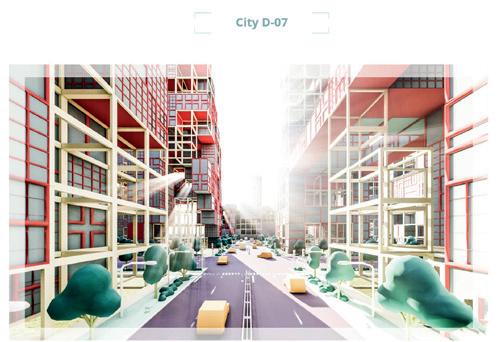
5 minute read
International Velux Award 2020, SunCity....................................................................................................................................... Professional
Suncity is an ‘massively multiplayer online/real-time strategy game’ that is challenging the players with creating cities and architectural forms to access equal daylight for cities against the rapid population growth and urbanisation.
The game experiments the dynamics of planning and architecture to the players and raise awareness about the daylight rights of buildings in the city. Each game is resulting with primitive design proposals of future city scenarios with a unique combination of forms. What is the aim..?
Advertisement
Build a city with growing population and adequate daylight usage. Use carve and substract tool to distribute daylight. Bring daylight to the facades and to the ground.
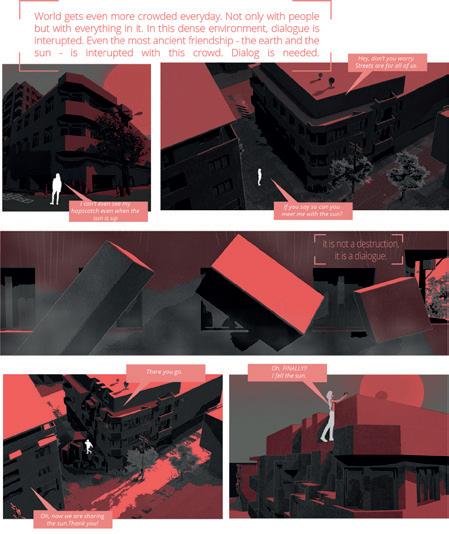
The city is a mutualist way of life. Each building has the right to receive sufficient light and protects the right of other buildings daylight accessibility. The buildings keep the general interest of the city in their own interest. Game of daylight to build a city with a growing population and adequate daylight usage. Use build and carve tool to distribute daylight throughout the city. If current trends continue, the global population will peak at 11 billion in 2100. City population will increase more than rural areas. By 2050, it is projected that more than two-thirds of the world will live in urban areas. Migration from rural to urban and the population growth causing to dense and rapid urbanisation. Apart from illegal settlements, regulations of planning and zoning law do not contain adequate regulations of daylight access. Access to the sunlight is crucial to have passive heating of buildings in winter and improve comfort conditions of people in the buildings, streets and open spaces. However cumulative structuring creates narrow streets, high buildings with fewer public spaces and the problem of the unequal living standards and access to sunlight. Healthier societies and living spaces require equal and adequate daylight access for each living and artificial things. In an equitable society, freedom of an individual ends where it impedes on the freedom of others.

Game Universe
The game the universe contains a globe and a star with earth and sun features and relationships. The globe contains 32 cities with different locations and geographical features. Each city is available for 5 players at the same time. Players can quit and involve the game through empty slots while the cities are constantly evolving to get adequate daylight usage for the specific requirements and constantly given challenges of each city. Each city has 400 square blocks (20x20) to be build to populate the required number of people while creating adequate park/public spaces and roads to access to each building blocks. Each block contains 25 units (5x5) and each unit populates a person. The game allows generating urban rules consistent with the climate context and needs of shading and sunlight for a given region. Sun/daylight is the main concern of the form-finding process in the game. Players are challenged with optimization of the required daylight access for each building and the city as a whole. With the help of sun diagram panel in the interface of the game, players can always check the areas that are in the solar field or shadow. The solar diagram shows the player the daily and yearly sun path for the specific city

How to Play?
After joining a city in the globe, players can start shaping the city to create equal daylight access throughout the city with the build and carving tools from the game set. Each tool involves different units to use. Build tool has different building blocks with different daylight accessibility rates. Carve tool involves blocks such as parks, roads or supporting scaffold to create empty areas and gaps between building blocks and allow daylight to pass through.

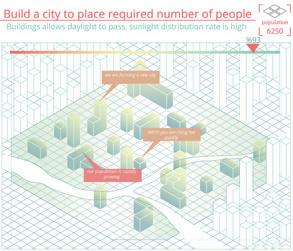
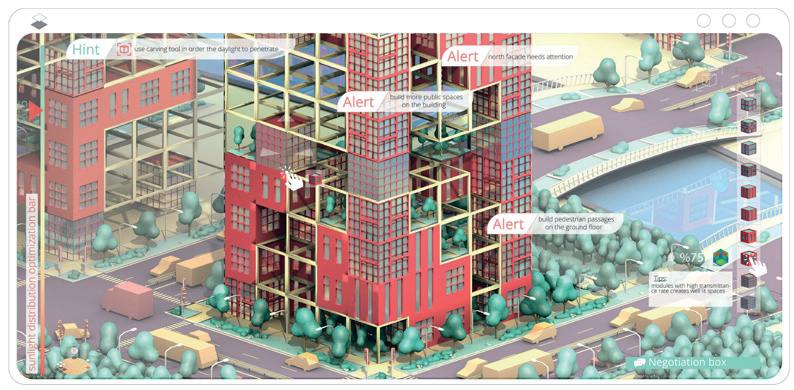


Players can build or carve with three different impact areas of 1 block, 9 blocks(3x3) and 25 blocks(5x5). Different ranges allows the player to build in city planning scale and also architectural scale. In the edges of the cities, there are 3 block space offsets that are under the control of the cities that is intersected. These common blocks can be built with the negotiation of the players of both cities through the chatbox.
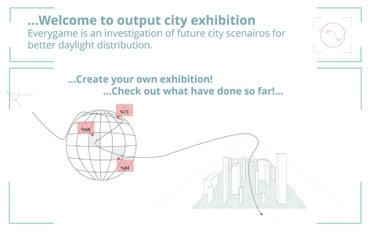
Open Exhibition
The game creates outcomes of the involving cities throughout the process to create an open exhibition of city patterns and architectural forms built by the players. Visitors or players can join the form-finding investigation exhibition of the daylight.
Rules and Challenges
1. The main rule and the main challenge is to create adequate daylight usage in each bock in the city. City-specific sunlight requirements should be considered to create the optimization in the daylight accessibility.
2. Players should populate the required and growing number of people in the city. If substracted a habitable block, the player should build it somewhere else instead.
3. Players should build the required number of parking blocks. These parks can be places on the ground or on the building blocks.
4. Each site is specified with different landscapes and dynamics to challenge the players that would either create gaps to allows the daylight to come easier or create blockages.
5. Players should negotiate with the intersecting cities for the common blocks and define an arterial road in the city to be connected to the intersecting cities’ arterial roads.





